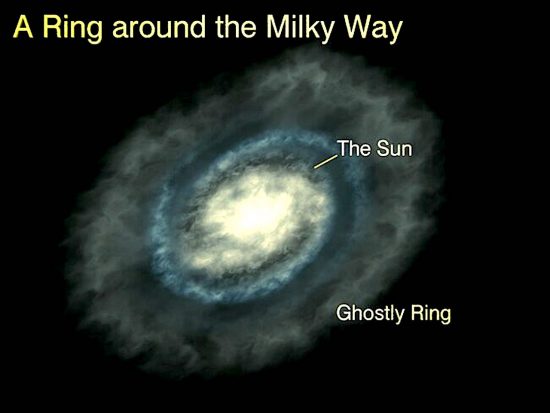
Dec 5, 2019
A ring of gas and stars is said to be orbiting the Milky Way.
Galaxies are mysterious. Astronomers are still not sure if they are a rotating collection of individual stars held together by gravity, or if they are a discrete object, behaving as a whole.
Consensus opinions state that galaxies spin because of how they form. A hypothetical cloud of gas and dust contracts, causing its spin-rate to increase. Spiral arms form, a disk of material surrounds the central nucleus, and gravitational eddy-currents inside the disk condense into stars. The spinning cloud is supposed to overcome its internal gravitational attraction with centrifugal force, flinging out material like drops of paint. Although, how a randomly moving cloud of particles acquires a net spin is unexplained by consensus astronomers.
A previous Picture of the Day discussed a ring of material circling the nucleus of Centaurus A. Active galaxies display axial jets and transverse, donut-shaped plasma discharges. Discoveries by the Herschel Space Observatory reveal that the Milky Way galaxy demonstrates similar active center plasma behavior.
According to a recent press release, the Milky Way is almost twice as large as previously thought. In 2003, a “mysterious” ring of stars was found at a distance of 120,000 light-years from the galactic center. This new discovery pushes the Milk Way’s diameter to 200,000 light-years.
Author of the paper, Carlos Allende, wrote:
“Using the metallicities of the stars in the catalogues from the high quality spectral atlases of APOGEE and LAMOST…we have shown that there is an appreciable fraction of stars…further out than the previously assumed limit…”
Hannes Alfvén’s “electric galaxy” states that galaxies are more like a homopolar motor/generator. A homopolar motor is driven by magnetic fields induced in a circular, conductive metal plate. The plate rotates between the poles of an electromagnet, causing it to spin at a rate proportional to the input current.
Galaxies are created within helical electric currents that flow in a great circuit through intergalactic space. The Bennett pinch effect squeezes plasma inside these cosmic “transmission lines,” confining vast clouds of ionized gas within electromagnetic fields, igniting stars and forming toroidal currents around the galactic equators. It is electrical current density that causes the plasma in stars to glow.
Since galaxies are part of a filamentary circuit of electricity that flows through the cosmos, they most likely spin because of electricity flowing through them like it does through Faraday’s motor. It is the Lorentz force that contributes the momentum for galactic rotation. Galaxies exist within an inconceivably large filamentary circuit of electricity. There is no way to know where this current flow arises, or to what electrode it is attracted, but we see the effects of its electromagnetic fields in the magnetism and synchrotron radiation that permeate space. The Milky Way’s ring is another way that plasma behaves.
Stephen Smith
The Thunderbolts Picture of the Day is generously supported by the Mainwaring Archive Foundation.












